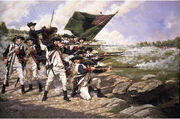| |||||||||||||||||||||||||||||||||||||||||||
The Second American Revolt (1806-1809), the American War for Independence, or simply the Revolutionary War in the American nations, was a war between United Kingdom and the rebellious American nations of New England, New York, Pennsylvania, Piedmont, and Michigan. The result of the war was an American victory.
The war was the result of decades-long tension between Great Britain and her American colonies following the end of the failed First American Revolt in 1775.
Background[]
War in the North[]
Massachusetts[]
Before the war, Boston had been the sight of much revolutionary activity, which lead the end of its self-government. On April 23, 1806, a sailor's revolt shut down Boston Harbor. British soldiers attempted to break up the mob, eventually leading to bloodshed. Fighting broke out, and many citizens used their own rifles to fight back against the British. The British lines were overrun by the sheer volume of rebels, forcing them to disperse across the city. When news of the fighting reached other towns, the militias there took up arms and seized the weapons at the Springfield Army. Governor William Hall sent a contingent of 700 British troops to stop the militias at Springfield. However, they

Militias ambushing the British during their march to Springfield
attacked by thousands of colonists along the way there. Hundreds of casualties were inflicted, forcing the British back to Boston.
Hall, not wanting to make the same mistake William Howe had made in the first revolution, placed several units on Dorchester Heights. In addition, 1,000 British troops had arrived by sea. By now, most of the rebellious citizens had escaped to join the militias in the countryside. The militias were organized under the command of Henry Dearborn, and then surrounded Boston, preventing the British from moving. On June 11, Dearborn led an assault on Dorchester Heights. After a day of heavy fighting, the British were forced to retreat. The rebels had suffered huge losses, and the siege continued. Hall attempted to regain the Heights three more times over the next three months, but failed each time. In August, cannons from the Springfield Armor had arrived, and the rebels placed them on the Heights. Realizing that the rebels once again had artillery overlooking the British positions, Hall evacuated Boston and sailed to the naval base at Halifax, Nova Scotia.
New York[]
When news reached New York of the rebellion, several militias were organized by William Hull into the New York Army. Similar to the situation in Massachusetts, the rebels had control of the countryside, while the British under Gordon Drummond controlled New York City. Hull led two daring attacks on Fort Ticonderoga and Fort Saratoga in June, capturing the armaments there. Hull planned tp trap the British in Manhattan and forcing them to surrender.

The Battle of Long Island was one of the biggest battles of the Second American Revolt
Hull marched toward New York, reaching the city in October. There, he discovered the British were building fortifications to protect themselves. Hull ordered his troops to charge, and the Battle of New York had begun. Hull, using British tactics, used the same battle plan they used in the Battle of Long Island 30 years ago. However, this time, the British were on the defensive. After 3 days of heavy fighting, Drummond concluded that he could not hold New York. During the cover of night, the British troops collected their ammunition and supplies and boarded the Royal Navy ships. By the time Hull attacked the next morning, the British were already gone.
War in the Northwest[]
War in the South[]
For the first year of the war, the majority of the fighting was done in the north, although a few rebellions had broken out in the countryside. Following their defeats at New York and Massachusetts, the British turned their attention south. They hoped to recruit large numbers of Loyalists in order to reclaim their lost northern colonies. On March 9, 1807, a British army under Isaac Brock captured Savannah, Georgia. The rebels attempted to retake the city three months later, but they were defeated. Brock then marched north, laying siege to Charleston, South Carolina, and captured the city and most of the rebel army in August. With few casualties, Brock had seized the south's biggest city and seaport, providing him a base for further conquest.
Most of the rebels fled to North Carolina, though a few partisan fighters remained. Known as "Swamp Foxes", the partisans, led by Andrew Pickens, raided British supply routes and committed hit-and-run raids, delaying the British invasion of North Carolina. A rebel army arrived to help, but Brock defeated them at Camden in December, opening North Carolina to the British.

Battle of Swift Creek
However, the British victories were at an end. The rebels, now led by Winfield Scott, had organized into a successful fighting force. Scott had managed to capture the central region known has Piedmont. Brock marched north, aiming to capture the city of Raleigh. Scott successfully defended the city after winning the Battle of Swift Creek, ending the British momentum and turning the tide of the war. Brock retreated back to Charlotte, and Scott laid siege to the city in May of 1808. Brock planned on receiving reinforcements from Louisiana, but the Swamp Foxes intercepted and defeated them. With supplies running low, Brock left the city and headed north to Chesapeake, hoping to be rescued there.
Brock's army, battered and tired by constant rebel ambushes, set up camp at Matthews, Virginia in July, waiting for the Royal Navy to arrive. However, after a long and destructive battle, the rebel navy, under the command of James Lawrence, managed to defeat the Royal Navy in the Battle of Chesapeake Bay. Brock was now surrounded by the rebel and Scott's approaching army. Brock hastily set up defenses, and Scott laid siege to his position for 20 days. Once again running low on supplies and with nowhere to retreat, Brock surrendered, and British operations in the South were over.



